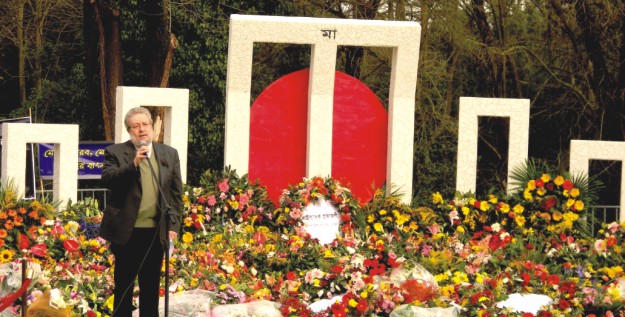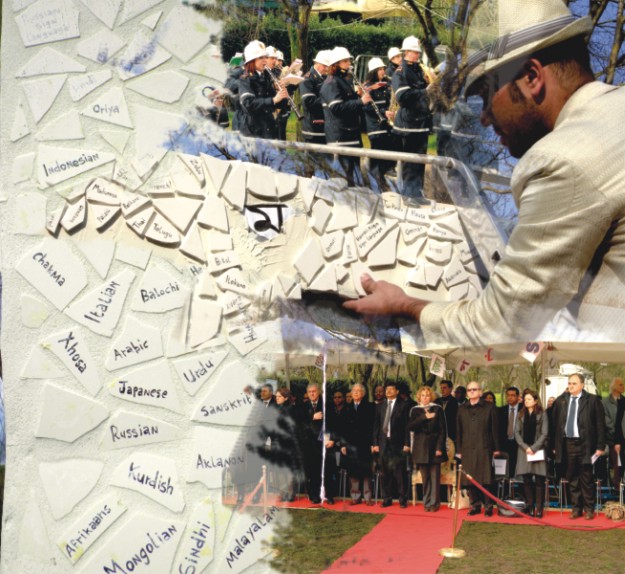| Home - Back Issues - The Team - Contact Us |
 |
| Volume 10 |Issue 09| March 04, 2011 | |
|
|
A Roman Column From Minar to Monumento to Art Neeman Sobhan
I am standing before a special monument in Rome. It's a damp morning of il ventuno di Febbraio for the Italian strollers and joggers at the Yitzhak Rabin Park. It is the 21st of February, but inside my culturally conditioned heart it registers in one Bengali word: 'Ekushey'. A scattering of thoughts set my mind pecking. I am thinking of that most basic element of our individual and collective identity, the spontaneous expression of our common humanity: Language. The language of speech and of writing; the language of poets and of peasants, of the pulpit and the pavement; the language of passion and of cold reason; the language of command and of compliance; the language of power and of protest…But above everything, language as mother tongue. And so my mind returns to the monument before me, dedicated to the mother tongue: mine, yours, theirs, ours. I look around me at the park and at the trees in the distance. A line from Tagore comes to me, a flicker from his collection 'Fireflies': "Trees are earth's endless effort to speak to the listening heavens." I am thinking of another tree, a memory tree. Fifty-nine years ago, we Bengalis planted a living, speaking tree that could talk to history– in our own voice, our own tongue. The one in Dhaka is a venerable oak, its rectangular limbs and branches, spare and white; its invisible blossoms carried to distant lands by its speakers. Here in Rome, I have come like others to salute the sapling we planted last year. the temporary monument. This year it has taken root, and today its permanent base is brimming with offerings of flowers and wreaths. Later in the day, there will be offerings also of songs, words and tributes, here at this newly constructed altar to language, in a programme organised by the Embassy of Bangladesh to commemorate 21st February and International Mother Language Day. Right at the start it has to be said that the Embassy of Bangladesh in Rome and its dynamic Ambassador Masud bin Momen worked earnestly for more than a year to establish this permanent memorial to the martyrs of our language movement of 1952, which would also be a monument to all the languages of the world. This year also happens to be a landmark year for Italy, celebrating 150 years of Italian unity. So Ambassador Momen felt the monument should also honour the host country which had provided the land and the support for it to stand. He got in touch with Paolo Tamburella, a well known Italian visual artist and film maker who also works with installation art. He was asked to create something special, with an Italian touch, keeping in mind both the accepted structure of the original Shaheed Minar of Dhaka, and the larger scope of UNESCO's International Mother Language day dedicated to linguistic and cultural diversity.
Paolo went to Dhaka for a month, studied the Shaheed Minar, and also the temporary replica at Yitzak Rabin Park in Rome, absorbing the significance of the central structure as the mother figure flanked by her sons fallen in the battle to preserve the right to call her name in their own language. He decided to use that quintessential Roman building material, white Travertine marble, and the traditional Italian artistic genre, the mosaic for the columns, and within each ceramic piece of mosaic he visualized the names of every major language in the world in which children call out their mother's name, making it a symbol of pluralism and peaceful coexistence. But the main part of the monument would be crowned with the single word 'Ma' written in the Bengali script. The construction work took many months in which the entire embassy rallied facing various challenges, among them the local residents of the prestigious Parioli area, who were initially disgruntled about the construction of a public monument in their park. Reassurances were issued by both the embassy and the municipality that the monument would only be used for peaceful purposes. Finally last week, the monument was unveiled and inaugurated by the Foreign Minister of Bangladesh in the presence of Italian dignitaries. The Italian government had donated the land and the Bangladeshi government had borne the expense. But the 21st of February was the real opening of the monument to the public. The day dawned moist but not rainy. The arrangement was well organised with red carpets, seats under canopies from which hung the Bangla alphabets and the names of Borkot, Rafiq etc. A huge red paper sun behind the monument substituted for the absent roman sun. An alpona design marked the travertine altar which was a veritable garden of flowers brought the evening before by almost 1500 local Bengalis. The staff and officers smilingly welcomed both the Italian, foreign and Bangladeshi guests and dignitaries. Among them was the guest of honour, Stephania Craxi, the Italian Deputy Minister Asia of Foreign Affairs. The programme started with the impressive uniformed police band of the Comune di Roma (Rome Municipality) playing the national anthems of both Italy and Bangladesh. After the strains of 'Fratelli d'Italia' had faded, it was moving to hear 'Amar Shonar Bangla' played soulfully by an all-Italian band, as was the lone military tune of lament, played while the gathering observed a minute's silence to honour the Bengali language martyrs. A short cultural programme followed with some graceful dances performed to patriotic songs by local Bengali artists and children, which were much appreciated. Then came the speeches. Most were predictable as ceremonial speeches usually are, but then two speakers followed one after the other, who lifted the discourse from the banal to the poetic, a fitting tribute to the protagonist of the day: Language. These speakers revealed the many ways that sensitive human beings share each others culture and language. One speech was by an Italian, Professor Zannini of the Italy-Bangladesh Friendship association, who touched every Bengali's heart by removing his shoes to stand near the altar and speaking in fluent and gracious Bengali. He is a shining example of how one can learn to speak, love and help nurture another language and culture, without being disloyal to ones own. The next speaker, Umberto Broccoli from the Italian Ministry of Culture spoke in his own tongue but started by quoting Tagore in Italian with reverence and deep affection: "Il mistero della vita/ penetra nel mistero della morte..." (The mystery of life penetrates the mystery of death..) He waxed on it saying that not only are life and death interconnected, but life is larger than death, and the passionately lived life resonates even after death. Martyrs leave testimony of their existence, which is never extinguished. He then revealed that where we stood was hallowed ground not just for Bengalis but for the pre-Romans too, who once buried their dead here. This area of the Salaria had hosted many ancient catacombs below the site of the language martyrs monument. What a serendipitous coincidence. Not only are life and death united and ever present, but people also are often at the confluence of each others disparate yet united histories and geographies. "Only connect" as E. M. Forester once said. The guest of honour, Stephania Craxi in her appreciation for the monument, the martyrs, and what it stands for spoke of the mother tongue as the language of love because it is spoken by the mother to her children, and thus the importance of protecting linguistic diversity since it promotes tolerance, mutual respect and fraternal harmony among people. She thanked the Bengali immigrant community for their hard work, their contribution to the Italian economy and for being a model of integration. The best surprise of the day was to have the Ambassador of Bangladesh deliver his speech not only in English and later in Bangla, but also in Italian. It was a fitting response to a day where multi-lingualism was being honoured. I was sitting next to an elegant African lady, the counselor of the Embassy of Zambia, and I told her that for the next 21st February celebration, I would like to help organise a parade of the languages of the world, with children carrying placards with the word 'Mother' or the name of their language written in the original script. She was enthused and I asked her the name of her language. She whispered in impeccable English, which is the official lingua franca of the country, that in Zambia there are over 70 spoken languages! Bemba, Kaonde, Lozi, Lunda, Luvale, Nyanja, Tonga….. I smile thinking that Zambia's procession alone would wind half way down the Park's pathway! And I had no idea of the linguistic richness of just this one country in Africa! This is also why the ritual of 21st February is necessary: it serves to remind all of us that we live in a world teeming with undiscovered cultural and linguistic wealth. It is our collective patrimony, our human heritage and we must protect and honour every language and culture as our own. Diversity and unity are not contradictory but connected. As a Roman Bengali I am proud of the Bangladesh embassy for providing a platform for multi-lingual solidarity in a world of increasing discord; for helping us prove that although we Bengalis ourselves struggled to give our language a homeland, we have created a sacred space to salute the 500 major and endangered human languages; for a piece of land where we have planted the tree not only of the history of our mother tongue but that of other speakers. This year is the 150th anniversary of Tagore, so he is constantly with me. He once wrote: "While God waits for his temple to be built of love, men bring stones." But today as I leave our Monumento Internazionale Permanente Alla Lingua Madre, I thank those who brought with love some travertine stones to build this simple temple to harmony in pluralism. I think in any language, God would be pleased. Copyright
(R) thedailystar.net 2010 |

